radiator TOYOTA YARIS HYBRID 2012 Owners Manual
[x] Cancel search | Manufacturer: TOYOTA, Model Year: 2012, Model line: YARIS HYBRID, Model: TOYOTA YARIS HYBRID 2012Pages: 704, PDF Size: 27.58 MB
Page 458 of 704
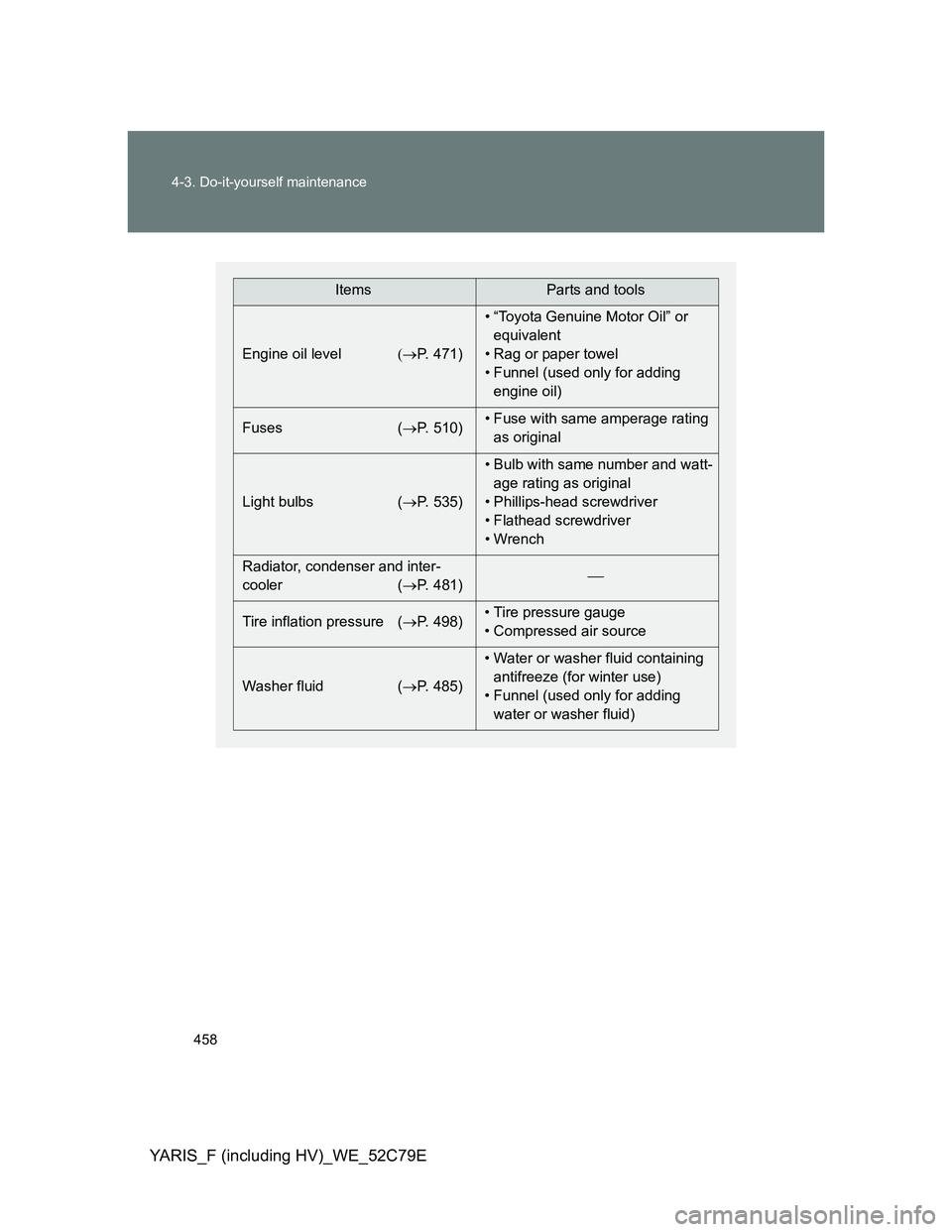
458 4-3. Do-it-yourself maintenance
YARIS_F (including HV)_WE_52C79E
ItemsParts and tools
Engine oil levelP. 471)• “Toyota Genuine Motor Oil” or
equivalent
• Rag or paper towel
• Funnel (used only for adding
engine oil)
Fuses (P. 510)• Fuse with same amperage rating
as original
Light bulbs (P. 535)• Bulb with same number and watt-
age rating as original
• Phillips-head screwdriver
• Flathead screwdriver
• Wrench
Radiator, condenser and inter-
cooler (P. 481)
Tire inflation pressure (P. 498)• Tire pressure gauge
• Compressed air source
Washer fluid (P. 485)• Water or washer fluid containing
antifreeze (for winter use)
• Funnel (used only for adding
water or washer fluid)
Page 460 of 704

460 4-3. Do-it-yourself maintenance
YARIS_F (including HV)_WE_52C79E
CAUTION
When working near the electric cooling fan or radiator grille
Except hybrid vehicle
Vehicles without a smart entry & start system:
Be sure the engine switch is in the “LOCK” position.
With the engine switch in the “ON” position, the electric cooling fan may
automatically start to run if the air conditioning is on and/or the coolant tem-
perature is high. (P. 481)
Vehicles with a smart entry & start system:
Be sure the “ENGINE START STOP” switch is off.
With the “ENGINE START STOP” switch in IGNITION ON mode, the electric
cooling fan may automatically start to run if the air conditioning is on and/or
the coolant temperature is high. (P. 481)
Hybrid vehicle
Vehicles without an electronic key:
Be sure the engine switch is in the “LOCK” position.
With the engine switch in the “ON” position, the electric cooling fan may
automatically start to run if the air conditioning is on and/or the coolant tem-
perature is high. (P. 481)
Vehicles with an electronic key:
Be sure the “POWER” switch is off.
With the “POWER” switch in ON mode, the electric cooling fan may automat-
ically start to run if the air conditioning is on and/or the coolant temperature
is high. (P. 481)
Safety glasses
Wear safety glasses to prevent flying or falling material, fluid spray, etc. from
getting in your eyes.
Page 467 of 704

467
4-3. Do-it-yourself maintenance
4
Maintenance and care
YARIS_F (including HV)_WE_52C79E
Engine compartment
1KR-FE engine
Fuse boxes (P. 510)
Engine oil level dipstick
(P. 471)
Engine oil filler cap
(P. 474)
Battery (P. 482)Engine coolant reservoir
(P. 478)
Electric cooling fan
Condenser (P. 481)
Radiator (P. 481)
Washer fluid tank (P. 485)
Page 468 of 704
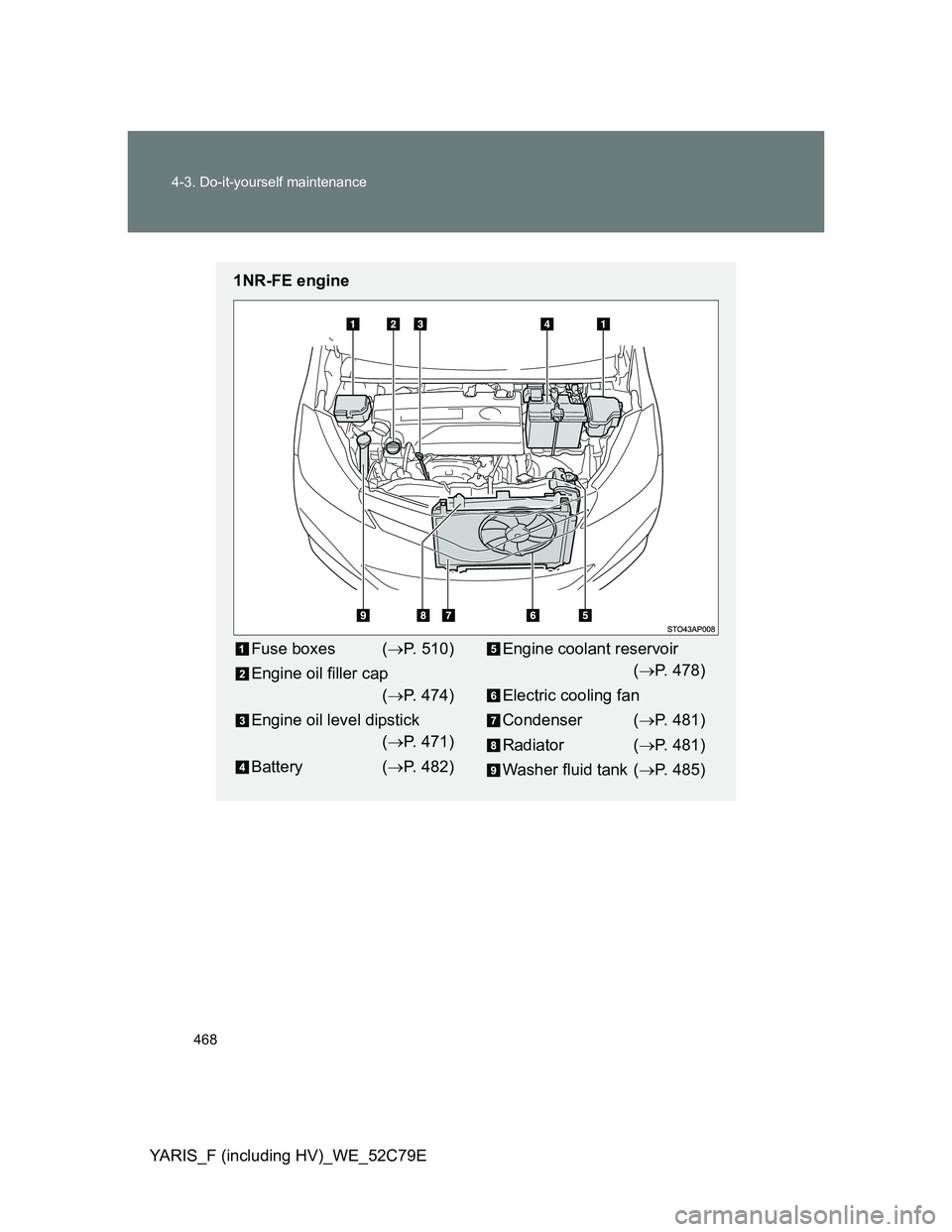
468 4-3. Do-it-yourself maintenance
YARIS_F (including HV)_WE_52C79E
1NR-FE engine
Fuse boxes (P. 510)
Engine oil filler cap
(P. 474)
Engine oil level dipstick
(P. 471)
Battery (P. 482)Engine coolant reservoir
(P. 478)
Electric cooling fan
Condenser (P. 481)
Radiator (P. 481)
Washer fluid tank (P. 485)
Page 469 of 704
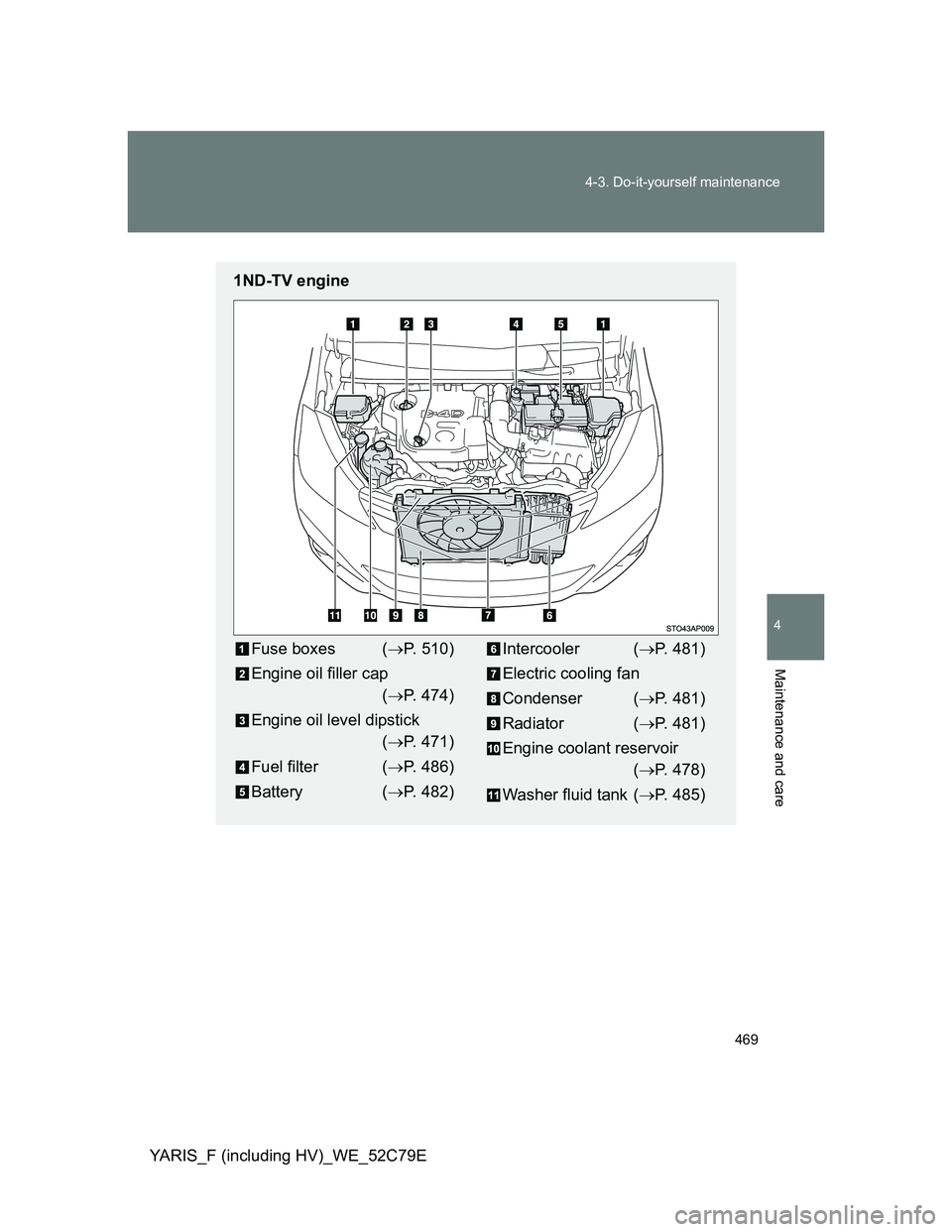
469 4-3. Do-it-yourself maintenance
4
Maintenance and care
YARIS_F (including HV)_WE_52C79E
1ND-TV engine
Fuse boxes (P. 510)
Engine oil filler cap
(P. 474)
Engine oil level dipstick
(P. 471)
Fuel filter (P. 486)
Battery (P. 482)Intercooler (P. 481)
Electric cooling fan
Condenser (P. 481)
Radiator (P. 481)
Engine coolant reservoir
(P. 478)
Washer fluid tank (P. 485)
Page 470 of 704

470 4-3. Do-it-yourself maintenance
YARIS_F (including HV)_WE_52C79E
1NZ-FXE engine
Fuse boxes (P. 510)
Engine oil filler cap
(P. 474)
Engine coolant radiator cap
Power control unit
coolant reservoir (P. 479)
Engine coolant reservoir
(P. 479)Engine/power control unit
coolant radiator (P. 481)
Electric cooling fan
Condenser (P. 481)
Engine oil level dipstick
(P. 471)
Washer fluid tank (P. 485)
Page 480 of 704
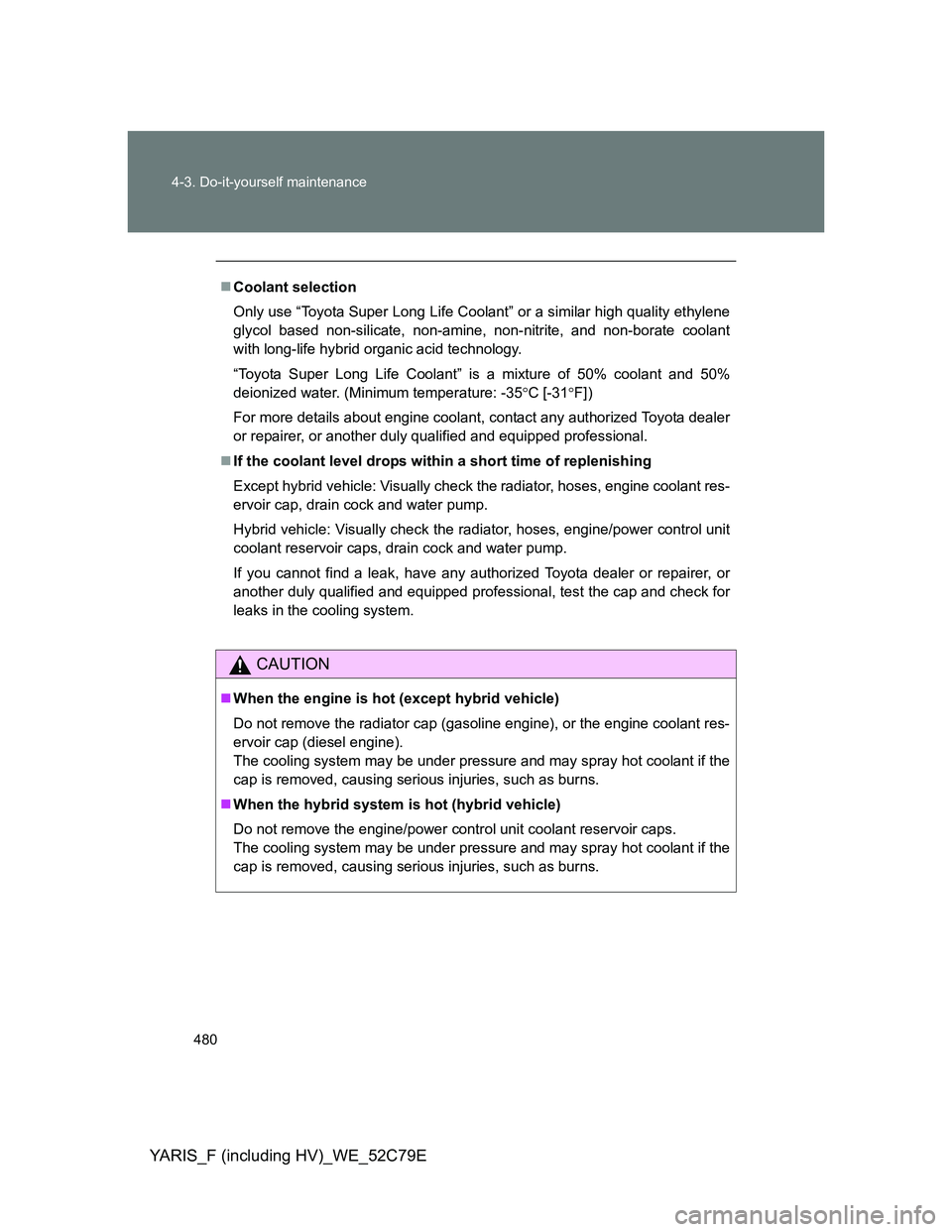
480 4-3. Do-it-yourself maintenance
YARIS_F (including HV)_WE_52C79E
Coolant selection
Only use “Toyota Super Long Life Coolant” or a similar high quality ethylene
glycol based non-silicate, non-amine, non-nitrite, and non-borate coolant
with long-life hybrid organic acid technology.
“Toyota Super Long Life Coolant” is a mixture of 50% coolant and 50%
deionized water. (Minimum temperature: -35C [-31F])
For more details about engine coolant, contact any authorized Toyota dealer
or repairer, or another duly qualified and equipped professional.
If the coolant level drops within a short time of replenishing
Except hybrid vehicle: Visually check the radiator, hoses, engine coolant res-
ervoir cap, drain cock and water pump.
Hybrid vehicle: Visually check the radiator, hoses, engine/power control unit
coolant reservoir caps, drain cock and water pump.
If you cannot find a leak, have any authorized Toyota dealer or repairer, or
another duly qualified and equipped professional, test the cap and check for
leaks in the cooling system.
CAUTION
When the engine is hot (except hybrid vehicle)
Do not remove the radiator cap (gasoline engine), or the engine coolant res-
ervoir cap (diesel engine).
The cooling system may be under pressure and may spray hot coolant if the
cap is removed, causing serious injuries, such as burns.
When the hybrid system is hot (hybrid vehicle)
Do not remove the engine/power control unit coolant reservoir caps.
The cooling system may be under pressure and may spray hot coolant if the
cap is removed, causing serious injuries, such as burns.
Page 481 of 704
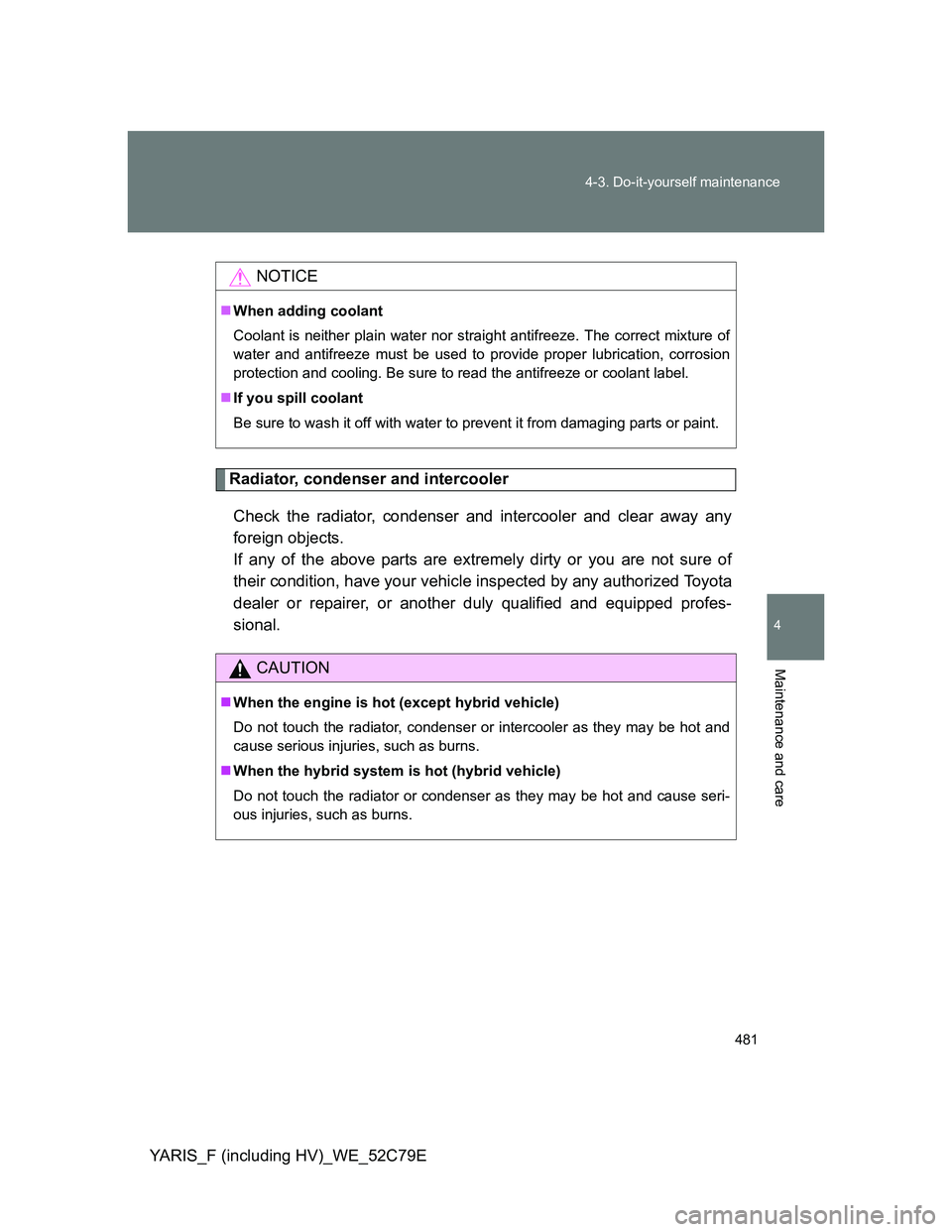
481 4-3. Do-it-yourself maintenance
4
Maintenance and care
YARIS_F (including HV)_WE_52C79E
Radiator, condenser and intercooler
Check the radiator, condenser and intercooler and clear away any
foreign objects.
If any of the above parts are extremely dirty or you are not sure of
their condition, have your vehicle inspected by any authorized Toyota
dealer or repairer, or another duly qualified and equipped profes-
sional.
NOTICE
When adding coolant
Coolant is neither plain water nor straight antifreeze. The correct mixture of
water and antifreeze must be used to provide proper lubrication, corrosion
protection and cooling. Be sure to read the antifreeze or coolant label.
If you spill coolant
Be sure to wash it off with water to prevent it from damaging parts or paint.
CAUTION
When the engine is hot (except hybrid vehicle)
Do not touch the radiator, condenser or intercooler as they may be hot and
cause serious injuries, such as burns.
When the hybrid system is hot (hybrid vehicle)
Do not touch the radiator or condenser as they may be hot and cause seri-
ous injuries, such as burns.
Page 635 of 704
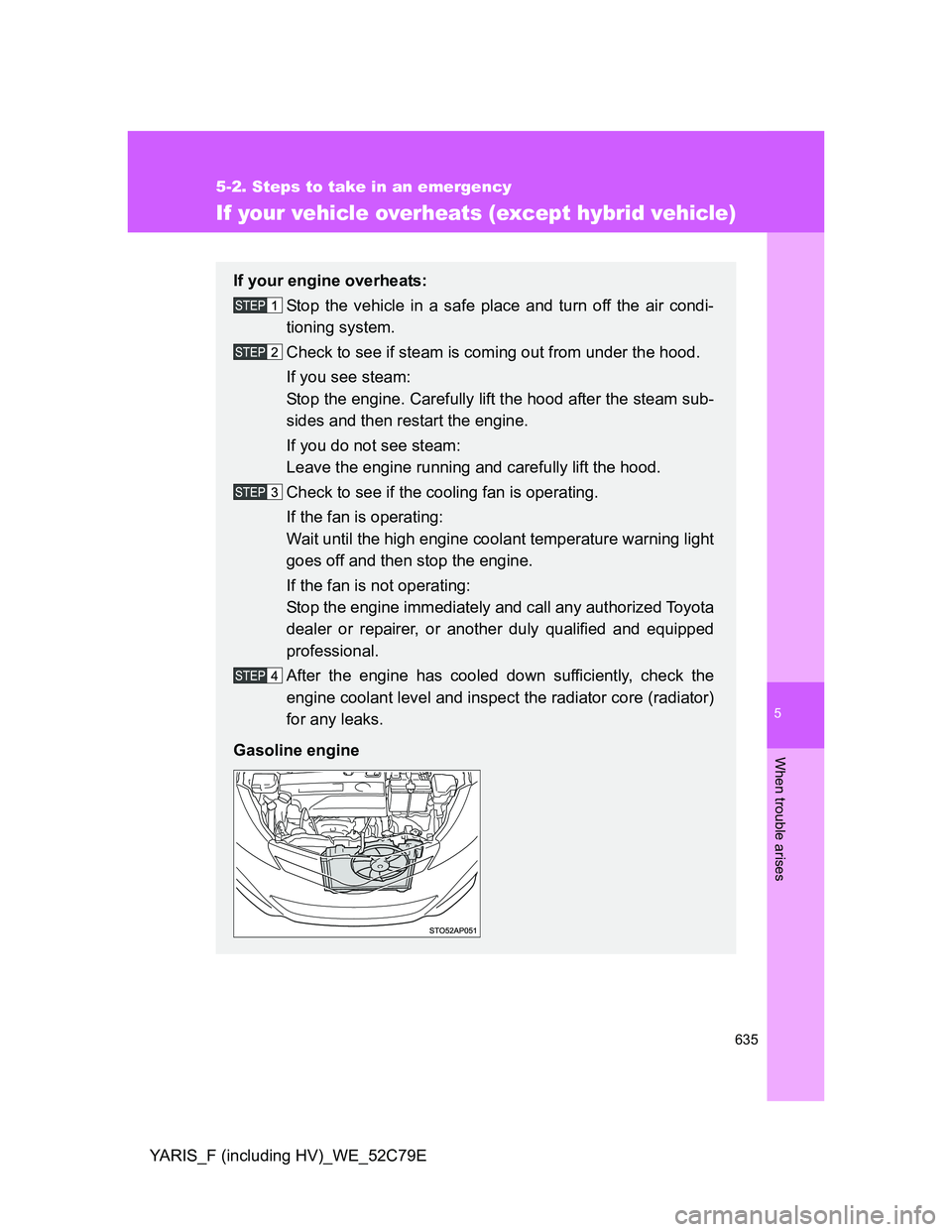
5
635
5-2. Steps to take in an emergency
When trouble arises
YARIS_F (including HV)_WE_52C79E
If your vehicle overheats (except hybrid vehicle)
If your engine overheats:
Stop the vehicle in a safe place and turn off the air condi-
tioning system.
Check to see if steam is coming out from under the hood.
If you see steam:
Stop the engine. Carefully lift the hood after the steam sub-
sides and then restart the engine.
If you do not see steam:
Leave the engine running and carefully lift the hood.
Check to see if the cooling fan is operating.
If the fan is operating:
Wait until the high engine coolant temperature warning light
goes off and then stop the engine.
If the fan is not operating:
Stop the engine immediately and call any authorized Toyota
dealer or repairer, or another duly qualified and equipped
professional.
After the engine has cooled down sufficiently, check the
engine coolant level and inspect the radiator core (radiator)
for any leaks.
Gasoline engine
Page 637 of 704

5
637 5-2. Steps to take in an emergency
When trouble arises
YARIS_F (including HV)_WE_52C79E
Overheating
If you observe the following, your vehicle may be overheating:
The high engine coolant temperature warning light flashes or comes on
or a loss of power is experienced.
Steam comes out from under the hood.
CAUTION
To prevent an accident or injury when inspecting under the hood of
your vehicle
If steam is seen coming from under the hood, do not open the hood until
the steam has subsided. The engine compartment may be very hot, caus-
ing serious injuries such as burns.
Keep hands and clothing away from the fan and drive belt while the engine
is running.
Do not loosen the radiator cap, or the coolant reservoir cap while the
engine and radiator are hot.
Serious injury, such as burns, may result from hot coolant and steam
released under pressure.
Diesel engine
Have the vehicle inspected at the nearest authorized Toyota dealer
or repairer, or another duly qualified and equipped professional as
soon as possible.